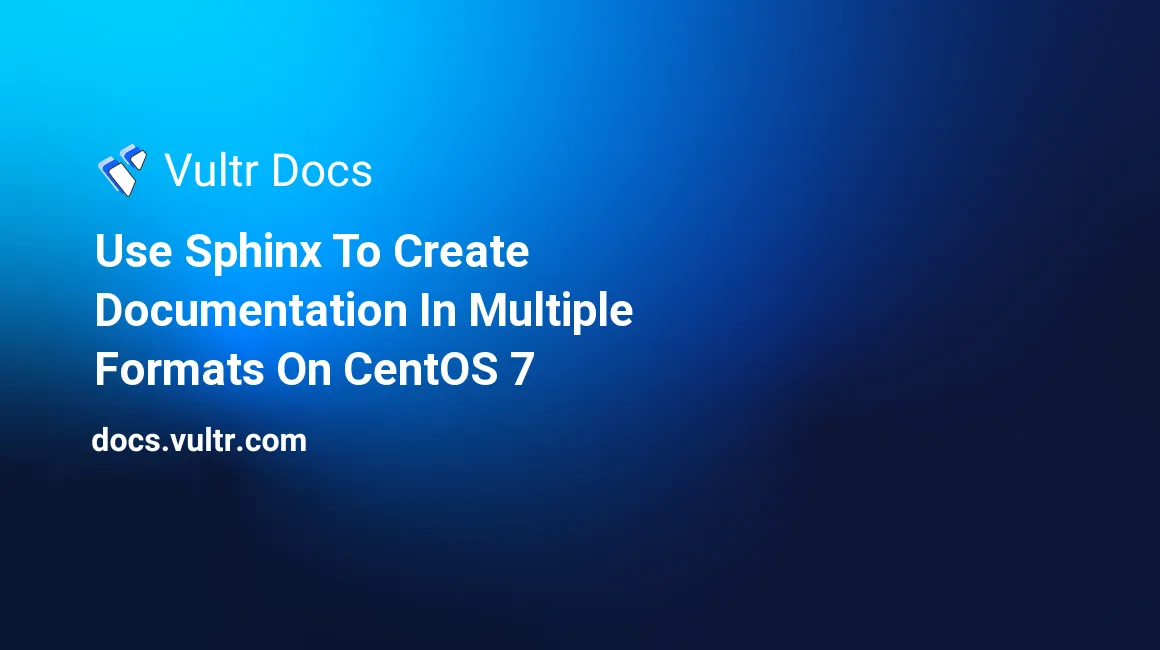
Sphinx is a useful Python-based tool for technicians and writers that allows them to easily create elegant, fully-functional documentation in various formats. With Sphinx, you write documents using reStructuredText -- a lightweight markup language -- for starters, then you can get the output in multiple formats, including HTML, LaTeX, PDF, ePub, and others.
In this tutorial, we will be covering the process of installing and using Sphinx on a CentOS 7 x64 instance on Vult’s platform.
Prerequisites
- A CentOS 7 x64 instance.
- A sudo user.
Step 1: Update the system
sudo yum update
sudo shutdown -r nowStep 2: Install pip and Sphinx
sudo yum install -y python-devel python-setuptools python-pip
sudo pip install --upgrade pip
sudo pip install -U SphinxStep 3: Setup the basic configuration for your documentation
Before starting to use Sphinx, you need to specify your source directory in which Sphinx will run and save all your documentation. Once you have created the directory you intend to use, you can then run sphinx-quickstart which will initialize Sphinx and create the required basic configuration.
sphinx-quickstart is similar to a setup wizard which will prompt you with questions that determine the aspects of your project.
cd ~
mkdir doc1
cd doc1
sphinx-quickstartStep 4: Construct the hierarchy for your documentation
By default, the sphinx-quickstart wizard will create several directories and files.
_build # The directory for containing Sphinx output
conf.py # The file containing your project configurations
index.rst # The master file containing the hierarchy of your documentation
make.bat # A Windows command file
Makefile # A file necessary for running the make command
_static # The directory for static files, including custom stylesheets, pictures, etc.
_templates # The directory for custom templatesLet's have a look at the master file, index.rst, which contains the hierarchy of your documentation; namely, the table of contents tree or toctree.
Open it with a text editor:
vi index.rstAs you review the file, you will notice a section called toctree. If you have other source files (*.rst) for your documentation, you will need to specify them in the toctree section:
.. toctree::
:maxdepth: 2
introduction
chapter1
chapter2
chapter3
moreIt is imperative to:
- Leave a blank row above your input.
- Do not suffix your source files with
.rst. - Place your source files in their respective order.
- Use only one file name per row.
- Indent your file names with
:maxdepth: 2.
Once you have completed your modifications, save your file and exit the text editor.
ESC
:!wqStep 5: Create source files specified above
The source files must be created with names that match what was previously specified in index.rst, otherwise they will not be included in the final output.
All of the source files must be compatible with the reStructuredText markup language. For more information, please refer to reStructuredText Primer.
Step 6: Output the HTML version of your documentation
Once you have finished composing your documentation, you can output your work in HTML format by executing the below command:
make htmlThe output will be saved in the directory ./\_build/html which includes everything necessary for viewing the file in a web browsing.
This concludes our tutorial.
No comments yet.